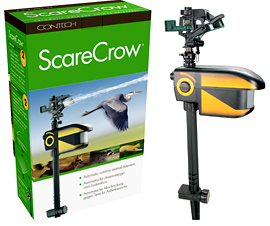
As a pet owner it’s pretty easy to care for our pets responsibly, but when it comes to what others do, we have less control. Take the plight of this cat lover for instance:
Our female, spayed, indoor-only cat is the recipient of unwanted nocturnal visits from a neighborhood male cat. We have floor-to-ceiling windows in our garden through which this intruding cat can practically touch noses with ours. Our cat howls, snarls and spits when he appears (usually in the middle of the night) and practically flings herself into the glass to get at him. We have tried lowering the blinds, turning on the sprinkler, and putting moth balls outside the windows, all to no avail. Currently we are keeping her locked in the kitchen at night, which we all hate, and today I’ve tried blacking out a portion of our windows so we can let her roam around the house. Aesthetically this is not a long-term option.
What else can we try? The owners were sympathetic to our plight but not willing to do anything. We already have a 14-month old baby who wakes up occasionally during the night, so feline screams are most unwanted.
Or you may see something more like this:
Good owners would supervise and pick up after their dogs, but in our rural-type area, off leash dogs do their business on my loose gravel-rock driveway. How can I prevent this?
And, of course, cats can cause potty (and even more stinky) problems too.
Says one victim of normal cat behavior, “What can I do to keep the local tomcat from spraying my front door? Or another owner who’s equally exasperated, “The neighborhood feline has made our yard his personal litter box. We have to remove kitty poop almost every day and have unsuccessfully tried spraying the affected areas with a mixture of water and bleach to deter the fellow. Do you have any suggestions?”
The Issue of Intruding Pets
Whether it’s neighborhood dogs leaving landmines for your walking pleasure or cats grafitti-ing your house with their pungent yellow perfume, other people’s pets-and their owners who fail to manage them responsibly-can be annoying.
Often it starts as a minor irritation-an occasional cleanup in your rose garden or a mild disruption at night. But when it happens over and over, it’s time to take action. First you try the sprinklers, but after using your yearly allotment of water on day one, you opt for plan B-pet safe repellent. Unfortunately, they either don’t repel or they need to be replaced more frequently than the batteries on a 4th grader’s Game Boy. Not to mention the fact that the culprit always finds the one repellent-less spot for his despicable deposit.
One Solution—A Motion-Activated Sprinkler System
For the average homeowner, these failures say wave the white flag, but for the persistent proprietor, it’s time for the ultimate animal-safe weapon: the Scarecrow, a motion detecting, water emitting, device designed to outwit even the wiliest trouble-making trespassers.
Here’s how it might work.
It’s the dead of night and a sleek cat names Sylvester heads to “the little boy’s room”- a lush patch of dirt between the tomatoes and zucchinis, in your backyard. He strides over with the confidence of Shaq heading down the center for a slam dunk and then “SHHPOP! chooka, chooka.” A wet surprise sends the startled Sylvester packing for home.
Sounds too good but it’s true. This sneaky sprinkler can detect both large animals such as giant breed dogs as well as smaller animals such as cats and chickens up to 35 feet away and within a 100 degree arc. The sudden sound coordinated with the quick burst of water is enough to deter even water-loving animals such as dogs and geese and larger animals such as deer.
Says Dr. Carol Popolow, a veterinarian from Croton-On-Hudson, NY who uses it primarily to keep deer away, “I can tell almost exactly how far the water sprays (or the scarecrow detects) from the height of the plants. My friend also uses it and her Hostas (a favorite deer snack) are lush and beautiful within the scarecrow area and eaten to the nubs in the area around it.”
The scarecrow also sprays Popolov’s cat who prefers to avoid the sprinkler-protected area. And I can personally attest that the device works wonderfully for keeping the average dog or chicken out of restricted areas.
As an added bonus, the scarecrow is easy to install, even for the mechanically impaired. Just add a 9 volt battery, attach it to a garden hose, and push its supporting stake into the ground. The only downsides are that it doesn’t work in winter if the temperatures get below freezing -ok, not a problem for most Californians- and the battery does need to be replaced every few months.
Revised from an article written in the San Francisco Chronicle on 6/6/01


